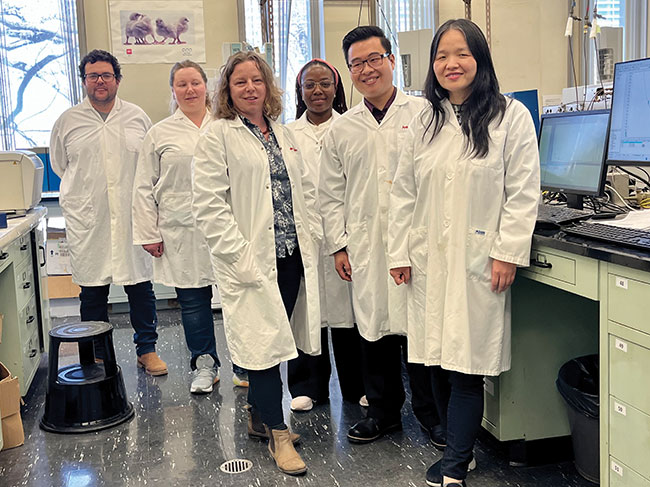
Yeast-based feed ingredients: a promising alternative to antibiotics
By Lisa McLean
Features Nutrition and FeedBreakthrough research reveals how yeast-based feed ingredients enhance poultry health. Here's a look at the key findings from this University of Manitoba-based initiative.
 Dr. Bogdan Slominski’s lab team has been working to find the right combination of enzymes to provide the most beneficial prebiotic components from yeast cell walls.
Photo: Dr. Bogdan Slominski
Dr. Bogdan Slominski’s lab team has been working to find the right combination of enzymes to provide the most beneficial prebiotic components from yeast cell walls.
Photo: Dr. Bogdan Slominski In the ongoing quest for alternatives to antibiotics, many poultry producers have adopted yeast-based feed ingredients because of the impact on growth and gut health. Now, at the conclusion of a five-year research study that dug deep into the novel bioactives of yeast, researchers are better equipped to understand how and why yeast-based feed ingredients improve gut function in poultry.
Dr. Bogdan Slominski, leader of the novel feed technology research program at the University of Manitoba, has been working with feed additives derived from yeast for more than two decades. His work has contributed to the development of different multi-carbohydrases and enzyme-pretreated yeast products for poultry from Canadian Bio-Systems, an industry partner.
“Foodborne diseases continue to be an important health and economic issue in Canada and abroad, and there is considerable work being done to replace antibiotics as growth promoters with antibiotic alternatives,” Slominski says. “We believe we have found an alternative in yeast-based bioactives, which have a prebiotic effect in poultry.”
The prebiotic effect
Prebiotics are nondigestible compounds that, as they are metabolized by microorganisms in the gut, have a beneficial physiological effect.
“Prebiotic components have a profound effect on the proliferation and function of the growth of beneficial bacteria to control pathogens and to ensure food safety,” Slominski says.
Yeast-based prebiotics improve bird health in two ways. First, they provide important nutrients that encourage “good bacteria” to grow in the gut, serving to lower gut pH and fight pathogens such as Salmonella, E. coli or C. perfringens.
Also, in saturating the binding sites in the bird’s gut, the enzymes stop the pathogens from attaching and growing.
But Slominski says the microbiota of the gastrointestinal tract of poultry is a complex community with around one million bacterial genes. His team has been working to find the right combination of enzymes to provide the most beneficial prebiotic components from yeast cell walls. To accomplish that, they had to break down the yeast cell wall polysaccharides first to access other specific and beneficial components, including nucleotides.
New generation sequencing
Slominski has worked to combine yeast products and their fractions to refine the products currently on offer. And, thanks to new sequencing technology, they are now able to gain a better understanding of the processes that happen in a bird’s gut.
“A newer tool called new generation sequencing (NGS) allows the genome structure of entire microbial communities to be studied, and to understand the structure and function of microbiota,” Slominski says. “In the case of chickens, it has been estimated that about 20 per cent of bacterial genes in the ceca control carbohydrate metabolism, and much less are involved in metabolism of amino acids and lipids. However, only a few studies have sought to understand the turkey microbiome.”
Turkeys
In the first part of the most recent study, Slominski’s team used a yeast-based growth promoter alone, and with other enzymes to measure how the additive modulates gut physiology of young turkeys to have an anti-inflammatory effect and generally improve essential functions and fight disease.
“We determined a diet with the multi-carbohydrase enzyme in combination with an enzymatically modified yeast cell wall can modulate the gut physiology and function of turkeys and could have anti-inflammatory effects due to an increased concentration of butyric acid in the ileal digesta,” Slominski says.
Laying hens
In another study using laying hens, researchers examined how different components used in a yeast-based growth promoter affected laying hens when they were challenged with Salmonella enteritidis (SE) zero, three and eight days post-infection.
Of the three types of yeast-based feed additives used in the study, each had different functions to support gut health. One reduced SE cecal counts and fecal shedding, and a second type of particle structure mitigated SE proliferation. The third type had little effect on SE, but it did support the growth of beneficial bacteria providing energy for gut development, function, and health.
“Each component plays an important role in supporting antibiotic-free feeding programs in poultry,” Slominski says.
Next steps
“As we conclude this project on yeast-based feed additives, we have a better understanding of how to develop products for prebiotic feed supplements,” Slominski says. He suggests further fine-tuning of yeast components would be best completed by industry partners.
Slominski sees opportunities for further research looking at the release of bioactive components from different natural fibre components. He expects his research associate and colleague Dr. Anna Rogiewicz to continue work with fibres from such feedstuffs as canola meal, soybean, and other grains and oilseeds. “With this research, we have better information about the microbiota of the gut and intestinal tract in poultry, and that gives us something to continue to build on,” he says.
This research is funded by the Canadian Poultry Research Council as part of the Poultry Science Cluster which is supported by Agriculture and Agri-Food Canada as part of the Canadian Agricultural Partnership, a federal-provincial-territorial initiative. Additional funding was received from CBS Bio-Platforms and Manitoba Egg Farmers.
Print this page